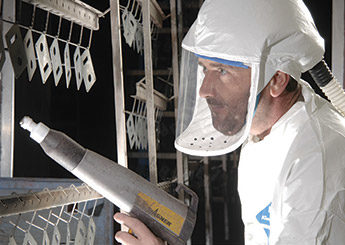Facial hair and respirator fit
A large number of men at our facility have beards, and I’m concerned that this could create problems with their respiratory protection. Can you provide any advice?

Responding is Eric Dietrich, product manager for respiratory protection, life sciences, Bullard, Cynthiana, KY
The long, full-beard look is a current fashion statement but presents a challenge to workers who are required to use respiratory protection. Popular cultural events such as “Movember” or “No-Shave November” – the male health counterpart to the popular Susan G. Komen pink ribbon campaign – pose safety concerns for employees and employers alike. The campaign encourages men to stop shaving during the month of November to raise awareness of men’s health issues. Although it’s a noble cause, supporting men’s health can inadvertently put those same workers at risk because facial hair can compromise the performance of tight-fitting respirators.
OSHA mandates that all employers requiring respirator usage have a written program. That program should include defining facial hair policies if tight-fitting respirator masks are used. Often, this is enforced only at the time of hire or at annual fit-testing, yet it is equally important to monitor and remind employees of the policy and its purpose. A mustache grown for a social cause is not necessarily a point of concern – as long as it is trimmed and maintained to the point that it does not violate the seal area of the respirator and the length does not interfere with exhalation valves, which prevent inward leakage of hazards during inhalation.
A good practice for the respirator program administrator might be to set a calendar notice for October reminding employees in a staff meeting or newsletter not to use “Movember” as an opportunity to trade health awareness for a real, in-the-moment health risk. The OSHA code to reference is 1910.134(g)(1) Facepiece Seal Protection. OSHA has cited employers for serious violations when it determined facial hair presented a possibility of serious injury or death.
Loose-fitting hoods and helmets that provide a level of protection up to 1,000 Assigned Protection Factor are options for employees who want to have facial hair. When suitable, they can also reduce the administration cost and time requirements of fit testing while maintaining broader employee morale and labor pool options. Although loose-fitting hoods still require OSHA written programs, medical clearance and training, they allow the employer options for providing reasonable accommodations when facial hair conflicts with tight-fitting respirators.
As “Movember” grows in popularity as an annual event, don’t get caught off-guard. Make sure your written program includes a facial hair policy and that you train, monitor and provide options for worker safety.
Editor's note: This article represents the independent views of the author and should not be construed as a National Safety Council endorsement.
Post a comment to this article
Safety+Health welcomes comments that promote respectful dialogue. Please stay on topic. Comments that contain personal attacks, profanity or abusive language – or those aggressively promoting products or services – will be removed. We reserve the right to determine which comments violate our comment policy. (Anonymous comments are welcome; merely skip the “name” field in the comment box. An email address is required but will not be included with your comment.)

